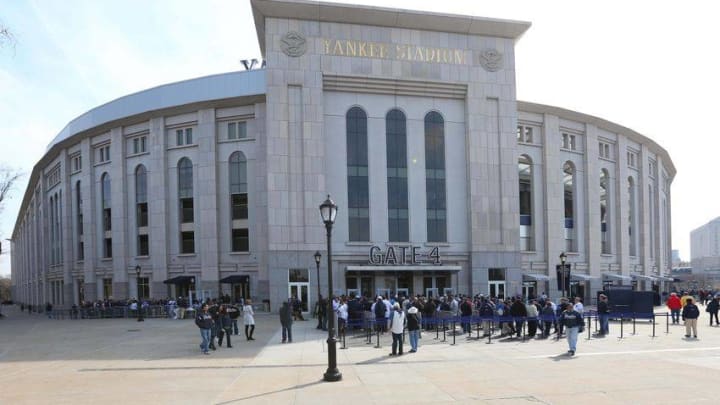New York Yankees: The Touring WWII Spy Moe Berg

New York Yankees catcher Moe Berg, a former American spy, has a story beyond the realm of imagination.
This past Sunday, my cousin Joe Contursi sent me an email saying, “Hey, do you know anything about this guy, Moe Berg?” I didn’t, but I decided I definitely wanted to know more about his fascinating story. Research followed and the following article came about.
Much of the detail and quotes for this article was culled from an exhaustive piece written by Ralph Berger. You can read the entire biography of Moe Berg found in The Society Of American Baseball Research, but I’ve condensed it for you here.
Moe Berg did, in fact, have a long though illustrious, career as a professional baseball player. But it would be for other reasons why his name would be etched into the lore of baseball.
Casey Stengel, who indeed was quite a character himself, once referred to Moe Berg as “the strangest man to ever play baseball.” He was said to be the master of 12 languages, including all of the classical ones like Latin and Sanscrit. At the behest of his father, he was forced to go to Princeton where he graduated and finished 24th in a class of 211. He then went on to earn a law degree at Columbia University.
Much to the chagrin of his father, after that, he turned down several lucrative job offers, finally getting around to doing what he wanted to do, which was playing baseball. Berg started his baseball career in 1923 with Brooklyn of the National League as a shortstop and batted a puny .186. He stumbled around in the minors for three years after that, finally making it back to the majors in 1926, when he played in 41 games for the White Sox, batting .221.
His switch from shortstop to catcher came about when Chicago’s two backstops went down with injuries in the same game. Never one to step away from a challenge, Berg quickly announced to the team, “I can do it!” And so, he did. He would go on to play in the majors for 15 years finishing with a pedestrian average of .243 in 1939.
But in 1934, his story gets really interesting. Readers may recall that prior to the attack on Pearl Harbor in 1941, the Japanese were making peace overtures to the United States. Eventually, a peace agreement was even signed with Japan prior to WWII.
To support these peace efforts, MLB sent New York Yankees Babe Ruth and Lou Gehrig. Also on the tour and under the guise of being a New York Yankee was- you guessed it – Moe Berg. Apparently, at the time Japan did not have as keen an interest in baseball as they do today, so the masquerade worked. But at the same time, no one in this country could understand what this guy Moe Berg was doing on the tour with these two giants of baseball.
At this point, the story gets a little murky. But this much is true. During the tour, Berg did indeed worm his way to the top of one of Japan’s tallest buildings and take motion pictures of the Japanese skyline in Tokyo. And we do know that General George Dolittle heard about his escapade and wanted to see the film for reasons that would become apparent years later.
More from New York Yankees
- Last Chance Caesars Promo: Claim $1,250 Bonus for ANY MLB Bet!
- Caesars New York Promo Code Gives TWO Chances to Win Betting on Your Yankees!
- PointsBet New York Promo: FIVE $100 Bonus Bets to Back the Yankees or Mets!
- Caesars NY Promo: $1,250 Bonus to Celebrate the Return of Judge!
- Get $500 in Bonus Bets to Back Yankees or Mets With PointsBet New York Promo
Was he a spy placed on the tour by the American Government in anticipation of war with Japan? Or, was he just a little “strange” as Stangel had labeled him, and he was simply acting on his own?
We do know this, though. According to the SABR biography, “In August 1943, Moe Berg was recruited into the Office of Strategic Services (OSS), later to become the CIA, by General William (Wild Bill) Donovan”.
Adding to the color of the story, we also know that “Berg was sent on one mission posed as a German businessman in Switzerland. His job order from the OSS was to carry a shoulder-holstered pistol and assassinate Werner Heisenberg, the top scientist suspected of working on an atomic bomb (if indeed the Germans were moving ahead on the A-Bomb). Heisenberg divulged nothing. Berg, who was to shoot him on the spot and then take cyanide to avoid capture, concluded that the Germans were nowhere close to an atomic bomb. Heisenberg and Berg were to live another day.”
Following his spy days, Berg continued his passion for baseball as an ardent fan of the New York Mets. He would “show up at Mets games, usually sitting alone in the right field stands, wearing his customary black suit and carrying a Neville Chamberlain black umbrella.”
Next: Who are the 5 greatest catchers in Yankees history?
Ever the eccentric and perhaps even a con man, Berg’s story is just another one of the many stories found in America’s Pastime that illuminate yet another larger than life baseball character.
According to SABR, Moe Berg died on May 29, 1972, in Belleville, New Jersey, after a fall at his sister’s home.